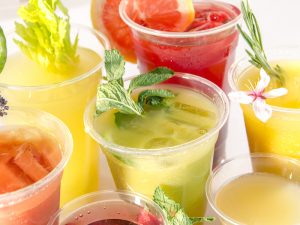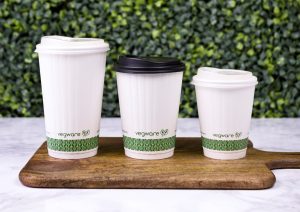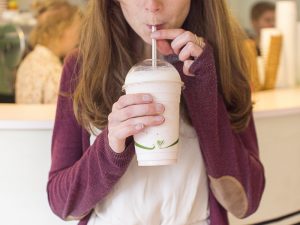All about PLA & CPLA – compostable bioplastics made from plant starches
At Vegware, we manufacture our catering disposables from a variety of plant-based materials. We use paper, board and pulp, but the big difference is that we don’t use conventional plastics.
Our cups still need to be leakproof, and our clients still want clear windows, so we use compostable bioplastics – compostable materials derived from plant sources.

What is PLA?
PLA is a compostable bioplastic derived from plant sugars. PLA stands for polylactic acid. It can be made from any sugar, such as corn starch, cassava, sugar cane, or sugar beet. NatureWorks is the world’s largest producer of PLA, and a key partner to Vegware. Industrial corn is the primary source crop at the moment, but NatureWorks are working actively to diversify feedstocks, investigating other fibrous non-food crops, or even creating lactic acid from carbon dioxide or methane.
NatureWorks refer to their PLA under the Ingeo brand, and offer full information online on how it is made, and end of life options.

How PLA is made
Corn plants are milled to extract the starch, in the form of glucose. The glucose is then fermented to produce lactic acid. Next up, a chemical process transforms the lactic acid into a polymer, which can be made into pellets, known in the industry as resin.
Just like a conventional plastic resin, the PLA pellets can be used in a variety of ways – extruded into a sheet or film, injection moulded, cast into sheets, or spun into fibres. PLA has a huge range of applications, but at Vegware we use it for:
- PLA-coated board for paper cups and soup containers
- Clear cold cups, salad containers, deli and portion pots, and lids for a variety of products
- Clear windows in sandwich wedges, salad boxes and bags

PLA pellets ready for a variety of uses
CPLA – crystallised PLA for higher heat use
PLA has a low melt point, so is best for cold use up to around 40ºC or 105ºF. Where more heat resistance is needed such as in cutlery, or lids for coffee or soup, we use a crystallised form. This involves adding chalk to the PLA to act as a catalyst, and then rapidly heating and cooling the PLA resin during production. The result is a product which is heat stable to 90ºC or 194ºF. Vegware’s CPLA products are still suitable for industrial composting, in either in-vessel or open windrow composting.

Corn for food, feed AND industrial uses
The industrial corn used to make NatureWorks Ingeo PLA is non-food-grade, so it is not competing with food for human consumption. The whole plant is harvested, and every part of it is used. The protein and starch have many different uses:
- the plant-based proteins are used to make animal feed;
- the starch has many industrial uses, including in airbags, corrugated cardboard, recycled paper, pharmaceuticals, condoms, oil refining and drilling…and making PLA.
Read more information on food and bioplastics from NatureWorks, the world’s largest producer of PLA.

Sustainable growing practices
The corn plants are grown using sustainable farming practices, without excessive pesticides and water use. In the same way that FSC can prove the sustainability of timber production, NatureWorks has independent ISCC PLUS certification – more info here. This in-depth scheme demonstrates the sustainable growing practices for the plants used by NatureWorks to make PLA:
- No sourcing from land with high biodiversity, high carbon stock or from peatland (2008 as the reference year).
- Agricultural practices (fertilizer & pesticide use, storage, disposal, tillage practices, equipment calibration, irrigation)
- Environmental protection (protect natural vegetation & water courses, soil erosion, soil organic matter)
- Social sustainability (child labour, workers protection, labour condition, land rights, training, water rights)
- Greenhouse gas emissions on farm level.
Implementing this scheme has involved helping farmers to alter their growing practices for greater sustainability.

PLA – which waste stream?
Vegware’s compostable catering disposables can biodegrade in under 12 weeks in commercial composting, which provides the perfect balance of microbes, moisture and warmth. Our Environmental team offer our clients unparalleled zero waste support – see point 2 in our Composting FAQ.
Where there is no access to industrial composting, used Vegware should be put in general waste. Vegware’s takeaway packaging is made from plants, not plastic, using lower carbon, renewable or recycled materials, and these sustainability benefits still apply no matter what happens to them after use.
- Used Vegware should NOT be placed in standard recycling bins which collect paper, plastics and metals, as those materials go to a different type of sorting facility. Another reason is that food waste harms the quality of mechanical recycling – the same applies to any used foodservice disposables.
- General waste goes to either incineration or landfill. If Vegware is incinerated, energy is produced. Incineration studies from NatureWorks, a key materials supplier of ours, show that their PLA bioplastic produces more heat than newspaper, wood or food waste; also that it produces no volatile gases and leaves little residue. Some in the waste sector prefer plant-based materials over conventional plastics as they give off fewer toxic gases.
- In landfill, studies have shown that compostable packaging is inert and does not give off methane.
- Please do not litter – compostable packaging is not expected to break down when discarded in the environment, and is not a solution to marine pollution.
- Home composting conditions vary with the skill of the householder, so we don’t make any claims there, but there have been successful trials using hot compost bins.

PLA – not a threat to plastics recycling
Compared to conventional plastics, bioplastics currently represent a tiny fraction of packaging, so it is not currently economical to sort PLA from other waste streams. If there is a major increase in bioplastics volumes, then waste sorting facilities can be calibrated to recognise and sort bioplastics using near-infrared identification. As well as composting, PLA is suitable for mechanical recycling into new PLA, as practised by Looplife Polymers in Belgium.
Studies have shown that low levels of bioplastics do not harm plastics recycling. German and Italian researchers have found there was no reduction to quality, up to these levels:
- Up to 3% PLA in post-consumer PP plastic recyclate (1)
- Up to 10% PLA in PS plastic re-granulates (1)
- Up to 1-2% PLA in recycled PET plastic short-spinning plant (2)
- Up to 10% MaterBi in the recycling of PE plastic shopping bags (2)
This information comes from (1) the report PLA in the Waste Stream, a report initiated by the German Ministry of Food and Agriculture. And (2) from CONAI, the National Packaging Consortium of Italy: Working Group Biodegradable Packaging Recovery Project report, 2012.
We don’t encourage anyone to put PLA into plastics recycling, but these studies offer comfort to plastics reprocessors, who are understandably keen to maintain quality.



